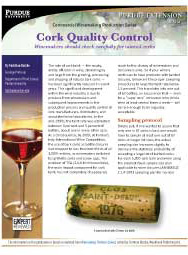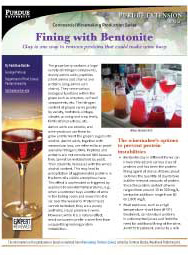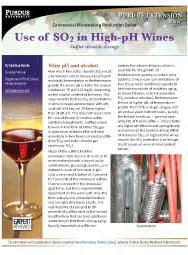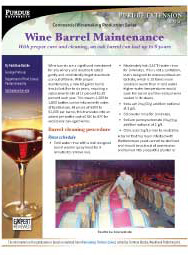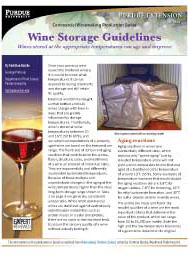Food & Nutrition
Wine
Commercial Winemaking Production Series: Chlorine Use in the Winery
This two-page fact sheet explains why not to use any chlorinated products anywhere in the winery. That's because chlorine, even at very minute levels, is one of the two major contributors to the production of 2,4,6-trich...
Commercial Winemaking Production Series: Cork Quality Control
Winemakers must check carefully for tainted corks, which can impart a musty, moldy off-odor to wine. This two-page publication tells how to sample corks....
Commercial Winemaking Production Series: Fining with Bentonite
Adding bentonite clay is one way to remove proteins that could make wine hazy. This five-page publication explains how much to add, based on the protein content of the wine, and answers seven common questions about how t...
Commercial Winemaking Production Series: Preventing Refermentation
Residual sugar can cause refermentation of bottled wine, and malic acid can cause carbonation in the bottle, possibly forcing out the cork. This two-page publication tells how to measure sugar and malic acid levels....
Commercial Winemaking Production Series: Traminette Vineyard Management
The white wine grape variety Traminette (Gewürztraminer x J.Seyve 23-416) has been selected as a signature variety to help create a regional identity for Indiana wines. This five-page publication advises producers o...
Commercial Winemaking Production Series: Traminette Winemaking
The Purdue Wine Grape Action Team has determined that the white wine grape variety Traminette (Gewürztraminer x J. Seyve 23-416) can be one of the most distinctive, productive, and valuable wine grapes in Indiana Th...
Commercial Winemaking Production Series: Treatment of Film Yeasts
Wild yeasts on the surface of wines in tanks and barrels can generate an off-aroma, and this three-page publication gives advice on how to avoid them. The No. 1 preventative is to keep tanks and barrels full, so there is...
Commercial Winemaking Production Series: Use of SO2 in High pH Wines
This three-page fact sheet explains the benefits of adding sulfur dioxide to wine and provides charts showing how much SO2 should be added to wines with pH levels ranging from 3.0 to 4.0....
Commercial Winemaking Production Series: Wine Barrel Maintenance
At prices of $300 to $1,000 per oak barrel, winemakers have a significant investment in those containers. With proper care and cleaning, a 60-gallon barrel can last up to six years. This two-page fact sheet tells how to ...
Commercial Winemaking Production Series: Wine Cold Stability Issues
Cold stabilizing a wine can help remove unstable potassium bitartrate ("cream of tartar"). When it is present in a white wine, a consumer could mistake the harmless and tasteless potassium tartrate crystals on the bottom...
Commercial Winemaking Production Series: Wine Storage Guidelines
The greatest storage hazards for wine are associated with elevated temperatures and temperature fluctuations. This four-page publication outlines what's too hot and what's too cold for wines....










